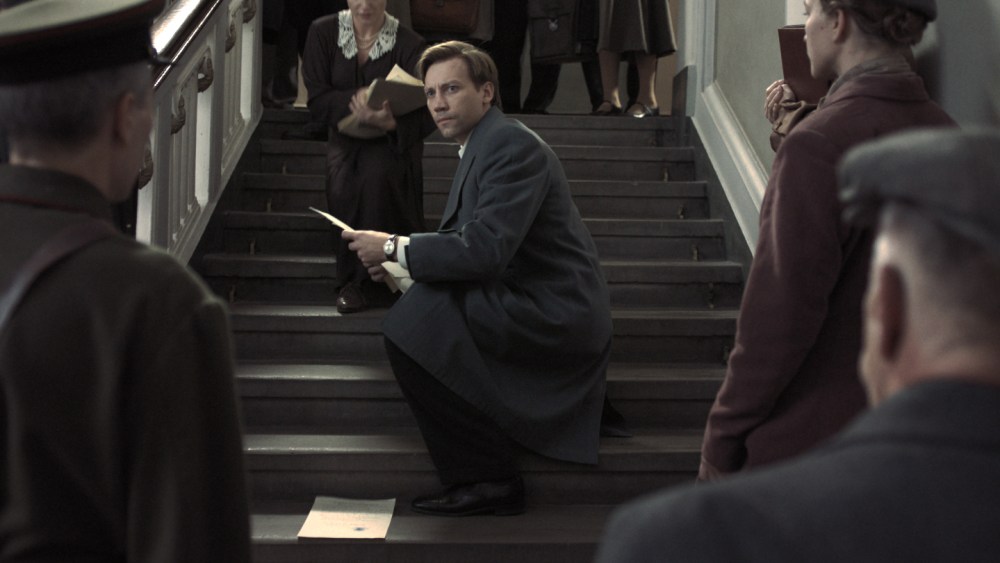We brought us into the opening door of Sergei Loznitsa, the pitch-black “two prosecutors” is in the form of a huge, scarred metal door that never had any benefit behind it. This was the Soviet Union in 1937, so the title quickly tells us: “Starin's horror peak”. There is no doubt that later, this incredible gateway will open for a second time, rather than the ending of the historic tragedy that ended behind the scenes, which reiterates Marx’s well-known motto, now repeating itself throughout our process, this time with a weird unsatisfactory craze.
The huge metal door is the entrance to the prison, which is the high quality of Oleg Mutu’s original paintings, locked, high quality of Academy-Ratio photography, thus saving a frustrating environment without pointing out Christiaan Verbeek’s excellent classical rating. While the axe guards in the scaffolding courtyard bark commands – from Jurij Grigorovič and Aldis Meinerts provide exquisitely made designs, where the shaky wooden background appears to be a huge Tic Tic-tac-toce, each square foot is X–are almost ridiculous trumpet trumpet and provides the entire picture and is associated with the entire open picture.
A group of reorganized, malnutritional prisoners were assigned to persevere in the related debris involving corruption and paranoid status. One such event, burning from the celebrations a bunch of huge unopened petitions, trustworthy “expensive Comrade Stalin,” a dated man imprisoned under some slim excuse, was pushed into a small room with a small range and played a game. The calming palette he sat, the man's pale, cold tender axes – probably a classic portrayal of Methuselah or Moses, and this uncured and ugly behavior of heroic cute frame is the ideal sample of the ironic Loznitsa.
Although he was told to destroy every message, there was one of them outdated Man Purloins in the middle: a card with only a few scratched phrases on it, which he stuffed into his too shirt. One thing about this notice prompted the poor creature to impose a dangerous gesture of pity. Maybe it was written in blood. Statistically unthinkable, like this tiny act of resistance, it is a much more unlikely, invisible chain of occasions, and then the notification actually arrives at the local prosecutor Kornyev (executed by the response to Break-Break-break-toblecout aleksandr kuznetsov, which makes the exciting eloquent efficiency unparalleled). Kornyev's profile and direct, incredible gaze outside his boxer is a completely new appointment, young, good, principled, and totally unprepared for his system of caring for these qualities.
Kornyev visited the prison and, in the way that he irritated statements and delayed the prison authorities (many “two prosecutors” composed of Kornyev Ready, sitting in a series of heavy chairs), he insisted on seeing Stepniak (Alexander Filippenko) (Alexander Filippenko), wrote the notice. Kornyev admitted to being a once respected thinker who legislatively talked about his Jubilee, telling his story of abuse and injustice on the subject of “The Facts of the Nice Bolsheviks”, while the locals (Secret Police) and Kornyev solved the case to go all out. On a seemingly endless staircase, in a huge municipal construction, his distant superior, the blank bureaucrat Vyshynsky (Anatoli Beliy) occupies an infinite workplace and an infinite workplace, and conducts quick, ruthless meetings for a strictly enforced schedule to respond to aiders.
It is based primarily on Georgy Demidov's AE book written in 1969, but the only one revealed in 2009, the story is not driven by any particular suspense – nonetheless, the story participated in any particular suspense in 2025, and could also have a moment of moment, or a record of an acquaintance's shock, because when a character is contrary to the tradition of “consultant”, “the consultant will change the consultant through ignorant consultants, and the place will be meaningless.” In any other case, retailers have some little surprises, and when historically after the fact, everyone knows more and more than Kornyev knows, and the second most immovable at the time was probably Loznitsa's trademark cynicism.
However, this is not in a sudden reveal or useless cinematic form. Of course, Kornyev's slow humiliation and disillusionment mediocrity may be a lot of purposes. The film’s obsession is in its material, the destruction of elements, the speed at which the fallen physique is away from the prison field, as if it was by no means the way it caught Kornyev stood out in the buzz.
Loznitsa's legacy is a necessary and influential documentary, but his last two novel choices – 2017's “Light Biology”, a nearly unsatisfactory train in social surrealism, and 2018's “Donbass”, an additional offensive black comedy – securely gained a lot. In the “Two Prosecutors”, perhaps out of respect for the content of the supply text, Loznitsa's performance was clearer than both titles, but the result was stronger, as if he had encountered some self-setting problems, and could effectively see a strict formal aesthetic that could evoke this terror that pervades the horror of residence and occupies the horror of the spiritual management of residence. It provides the expertise to watch “Two Testers” like studying slim paperbacks from Camus or Kafka or Orwell, where the page notices as it ages, but these insights remain painful, vividly modern.
Posts Sergei Loznitsa's Dark Ridiculous Odyssey Appear first Allcelbrities.

